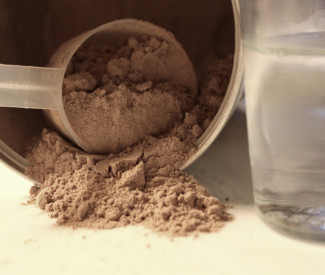Is it safe for diabetics to consume protein powder? Yes, however, it is important for diabetics to choose a powder that is sugar-free and as close to pure protein powder as possible. Many protein powders have artificial flavors and added sugars to make the powder taste more palatable. For this reason, diabetics should check the nutrition label and ingredients list carefully.
Also, when making protein shakes, diabetics also need to be mindful of the added ingredients they use to flavor the shake. Fruits, for example, are often added to protein shakes to give them flavor and increase nutritional value. Diabetics should keep in mind, however, that sugar from fruits that have been liquefied in the blender absorb into the bloodstream much faster than whole fruits.
Protein powder and diabetes
Increasing dietary protein is an excellent way for diabetics to control blood sugar. Why? The human body needs about 50 g of protein per day to perform daily maintenance. This includes building tissue and growing hair, fingernails, and muscle. If you work out, the body will need more protein.
Any extra protein in the diet converts to sugar. However, protein converts to sugar comparatively slowly. The process takes about three hours. This slow release of sugar helps prevent a spike in blood sugar for diabetics.
Protein powder can also help diabetics in other ways. It promotes weight loss by keeping you full (satiety) for hours after consuming it. The slow digestion of protein means you won’t get hungry for the next meal or snack quickly.
Additionally, studies have shown that when protein powder is added to a meal, it produces a greater insulin response diabetics. Blood sugar levels are lower after consuming protein powder than after a meal without it.
Best type of protein powder for diabetics
Any type of protein powder is simply protein isolate. It is obtained most commonly from whey (milk), and sometimes other sources, such as soy. Whey protein powder tastes bitter. It doesn’t agree with me, personally. So I make my shakes with soy protein powder. Soy powder has a neutral taste. It just tastes powdery.
Protein powder from any source is fine for diabetics as long as there are no added sugars. Pure protein powder is 100% protein and, as mentioned, will not significantly raise blood sugar levels in diabetics. Be warned, though, that protein powder is an acquired taste. It just tastes thick and powdery, and in the case of whey, it is bitter. It takes a while to get used to.
I prefer to buy my protein powder in bulk and make my own shakes. Premade protein shakes marketed for diabetics are available, but I’ve actually never tried one. I just like to make my own shakes.
Where best to buy protein powder? Big containers of protein powder can be difficult to find in retail stores. Often you have to go to a specialty store, and often the prices are ridiculous. So I always order mine online from Amazon because they have a gazillion choices and way better prices than you find locally. Click here to browse their sugar free varieties, and again, I recommend you try soy-based protein powder if it is your first time.
How to make a protein shake with low glycemic index
The beauty with making your own protein shakes is that there are a million different directions you can go. The only limitation is your imagination, and the only constant is water and protein powder. You can add almost anything to protein shake to keep it fresh and prevent boredom.
As a diabetic, though, you have to remember that everything in the shake is, by definition, liquefied. And liquids digested much faster than solid foods. So any sugars in a shake are going to be quickly absorbed and quickly raise blood sugar. Fruits high in fiber and lower in simple sugars are better for diabetics. Avocados, bananas, blueberries are great choices.
Whole grains are also excellent additions to protein shakes for diabetics. Barley, rye, quinoa, etc. There is a whole section in the grocery store with various bags of whole grains that are perfect for shakes. Whole grains are complex carbohydrates which absorb slowly in the digestive system. They also have lots of nutrients.
Nuts and seeds are also excellent additions to protein shakes. Flax seed is one of my favorites because of it’s awesome health properties. Make sure you pre-grind flaxseed prior to adding to your shake, though. Otherwise, the seeds will pass through your system undigested.
And you can add a small handful of almost any kind of nut to a protein shake. They are always delicious. Almonds, cashews, walnuts, pecans. Any kind of nut.
When’s the best time to have a protein shake? If you do cardio or weightlifting, after a workout, obviously. I absolutely love the protein shake after a weightlifting session. Not only does it help with building muscle, but it helps to suppress the ridiculous appetite I always get afterwards. Otherwise, breakfast is perfect time for a shake.
Final thought
As a diabetic, make sure you test your blood sugar any time you start out with a new protein powder mix. Even though the label may indicate that sugars are low, the actual effect on your blood sugar can be unpredictable. The only way to know for sure is to test and test again.
I hope this information was helpful for you. Please let me know in the comments below your own personal experience with protein shakes. Is there any pertinent advice can you give to me or other diabetics? Thank you.
Choose your protein powder
 |  |  |  |
| Whey protein powder | Soy protein powder | Sugar-free protein powder | Organic protein powder |
Photo credit: “Instant Protein” by las – initially is licensed under CC BY-NC-ND



Leave a Reply